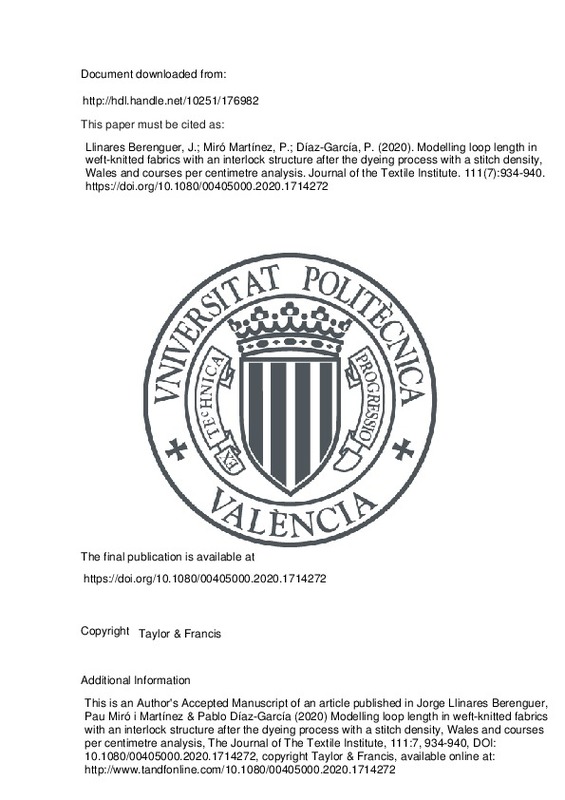JavaScript is disabled for your browser. Some features of this site may not work without it.
Buscar en RiuNet
Listar
Mi cuenta
Estadísticas
Ayuda RiuNet
Admin. UPV
Modelling loop length in weft-knitted fabrics with an interlock structure after the dyeing process with a stitch density, Wales and courses per centimetre analysis
Mostrar el registro sencillo del ítem
Ficheros en el ítem
| dc.contributor.author | Llinares Berenguer, Jorge
|
es_ES |
| dc.contributor.author | Miró Martínez, Pau
|
es_ES |
| dc.contributor.author | Díaz-García, Pablo
|
es_ES |
| dc.date.accessioned | 2021-11-11T19:30:39Z | |
| dc.date.available | 2021-11-11T19:30:39Z | |
| dc.date.issued | 2020-07-02 | es_ES |
| dc.identifier.issn | 0040-5000 | es_ES |
| dc.identifier.uri | http://hdl.handle.net/10251/176982 | |
| dc.description | This is an Author's Accepted Manuscript of an article published in Jorge Llinares Berenguer, Pau Miró i Martínez & Pablo Díaz-García (2020) Modelling loop length in weft-knitted fabrics with an interlock structure after the dyeing process with a stitch density, Wales and courses per centimetre analysis, The Journal of The Textile Institute, 111:7, 934-940, DOI: 10.1080/00405000.2020.1714272, copyright Taylor & Francis, available online at: http://www.tandfonline.com/10.1080/00405000.2020.1714272 | es_ES |
| dc.description.abstract | [EN] One of the variables that we need to know in knitted fabrics in order to explain variations in dimensions in their different relaxation states, which might occur during the production process, is the yarn length that a loop forms, known as loop length. To experimentally calculate it, quite a lengthy process is required and the following need to be identified: direction of wales, direction that samples unreave in, counting the number of loops in the fabric length, separating and measuring yarn with specific measuring equipment, and repeating these 10 times, according to regulation UNE-EN 14970. Thus, depending on the structure type to be analysed, the whole process can take a relatively long time to do this calculation. This study proposes a calculation system that simplifies the process, for which the yarn length absorbed by an estimated interlock structure was modelled, as was loop length, without having to follow such a time-consuming process. | es_ES |
| dc.language | Inglés | es_ES |
| dc.publisher | Taylor & Francis | es_ES |
| dc.relation.ispartof | Journal of the Textile Institute | es_ES |
| dc.rights | Reserva de todos los derechos | es_ES |
| dc.subject | Knitted fabrics | es_ES |
| dc.subject | Loop length | es_ES |
| dc.subject | Stitch density | es_ES |
| dc.subject | Wales per centimetre | es_ES |
| dc.subject | Courses per centimetre | es_ES |
| dc.subject.classification | ESTADISTICA E INVESTIGACION OPERATIVA | es_ES |
| dc.subject.classification | INGENIERIA TEXTIL Y PAPELERA | es_ES |
| dc.title | Modelling loop length in weft-knitted fabrics with an interlock structure after the dyeing process with a stitch density, Wales and courses per centimetre analysis | es_ES |
| dc.type | Artículo | es_ES |
| dc.identifier.doi | 10.1080/00405000.2020.1714272 | es_ES |
| dc.rights.accessRights | Abierto | es_ES |
| dc.contributor.affiliation | Universitat Politècnica de València. Departamento de Ingeniería Textil y Papelera - Departament d'Enginyeria Tèxtil i Paperera | es_ES |
| dc.contributor.affiliation | Universitat Politècnica de València. Departamento de Estadística e Investigación Operativa Aplicadas y Calidad - Departament d'Estadística i Investigació Operativa Aplicades i Qualitat | es_ES |
| dc.description.bibliographicCitation | Llinares Berenguer, J.; Miró Martínez, P.; Díaz-García, P. (2020). Modelling loop length in weft-knitted fabrics with an interlock structure after the dyeing process with a stitch density, Wales and courses per centimetre analysis. Journal of the Textile Institute. 111(7):934-940. https://doi.org/10.1080/00405000.2020.1714272 | es_ES |
| dc.description.accrualMethod | S | es_ES |
| dc.relation.publisherversion | https://doi.org/10.1080/00405000.2020.1714272 | es_ES |
| dc.description.upvformatpinicio | 934 | es_ES |
| dc.description.upvformatpfin | 940 | es_ES |
| dc.type.version | info:eu-repo/semantics/publishedVersion | es_ES |
| dc.description.volume | 111 | es_ES |
| dc.description.issue | 7 | es_ES |
| dc.relation.pasarela | S\401046 | es_ES |







![[Cerrado]](/themes/UPV/images/candado.png)

